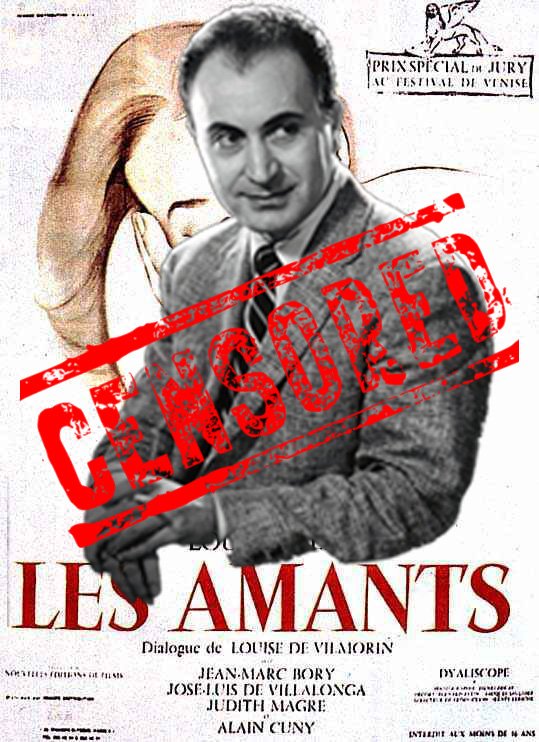
One of the most well-known court phrases of all time comes from the Supreme Court obscenity trial Jacobellis v. Ohio (1964) against theater operator Nico Jacobellis (pictured above) for screening the 1958 French drama “Les Amants” (or “The Lovers”) in his small movie theater. On the question of defining “hard-core pornography”, Justice Potter Stewart infamously said in his ruling, “I know it when I see it, and the motion picture involved in this case is not that.”
The scene in question briefly shows a nipple and implies cunnilingus (see photos below), but perhaps most obscene to viewers at the time was that it suggested a female orgasm. Because the sex is purely for pleasure (and the woman’s pleasure at that), without even a possibility of procreation, I think this made it more offensive. There is so much tenderness between the characters in this scene.. maybe it’s because the woman was having an affair that made it more difficult for people to face.
After screening “The Lovers” in 1959, Jacobellis was found guilty of possessing and exhibiting an obscene film. The ruling was consistently upheld in appeals by all three lower courts until 1964 when the Supreme Court of the United States reversed the ruling in a 6-3 decision. Despite having a majority opinion to overturn the ruling, there was no agreement among the six justices for the specific reasoning as to why it was not “obscene” and the court produced four different dissenting opinions.
This notable case fell between the two landmark rulings for obscenity, Roth v. United States (1957) and Miller v. California (1973). Before Roth, any obscene passage alone could deem an entire work obscene. This began shifting in 1933 with United States v. One Book Called Ulysses (by that old-school type of pervert, James Joyce). One of the primary changes with the Roth ruling in 1957 was reviewing a work in its entirety as well as against “community standards.” In the court’s Jacobellis ruling, we see how the work was viewed as a whole, but that it was measured against standards “not …of the particular local community from which the case arises, but those of the Nation as a whole.” In 1973 with Miller, community standards became more open to interpretation, not nationalized but localized to better facilitate the right of states to make these determinations for themselves. But what about those rabble-rousers who are shaking up the status quo, how can they be protected? The fact that a majority agrees on something does not in itself prove it to be just or true.
Another significant change in the obscenity review process was whether the works DO possess some sort of “serious” value (the current measure under Miller) as opposed to NOT having any sort of “socially redeeming” value (the measure under Roth). This similarly broadened interpretations of the law, and it seems that in every generation, about every 20-30 years, there is some kind of social reckoning with what is considered obscene and how to measure it. The case Florida vs. Diana (1994) demonstrated that while the law itself did not change in the 90s, underground comic artist Mike Diana became the first artist to be convicted of obscenity in the United States, and his appeal was denied by the Supreme Court. We are currently in another one of those social reckonings, renegotiating standards and redefining what “community” even means when the Internet has connected people around the world.
60 years after Jacobellis, it’s not hard to imagine this current SCOTUS configuration ruling in the opposite direction. With the 2022 reversal of Dobbs v. Jackson (aka Roe v. Wade), it’s only a matter of time before we see more fundamentalist-oriented legislation introduced to advance these fringe religious and political agendas. The most significant thing to me about “obscenity” is the fact that it is not protected under the First Amendment, and the bar is being re-established by deranged and sex-obsessed Evilangelicals. Whether you support or understand gender politics or not, the targeting of trans people and trans youth in particular is an indicator of the moral direction those with power are steering this country. Deviations from the norm are being quite literally erased, first from within the pages of textbooks to entire books themselves; from their writers and readers to those who have yet to find their way to the library for the first time. They’re erasing history and erasing futures. They want people back in the closet, back in the kitchen, or dead. The existence of people living outside of the gender binary is a direct attack on its imposition from before birth – they basically can’t handle people being out and having no control over them. That’s what I love about this generation, they don’t give a fuck. I think we’ll see more state laws cementing bigotry as a standard, restricting language and liberties, ushering in another review of obscenity before the Supreme Court in the next 3-6 years.
0 Comments